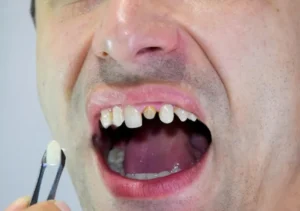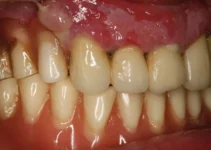A dental abscess is a pus-filled pocket that forms in different parts of a tooth due to bacterial infection. It typically results from severe tooth decay, gum disease, or a broken tooth that allows bacteria to infiltrate the pulp material inside the tooth. The condition can cause significant pain, swelling, and redness. Immediate treatment often involves draining the abscess, eliminating the infection with antibiotics, and ensuring proper dental practices to avoid future occurrences. Understanding the causes and effective management strategies is crucial to prevent potential complications such as the spread of infection to other areas of the body.
What is a Dental Abscess?
A dental abscess is a localized infection within a tooth or the surrounding gums that results in the collection of pus. This condition is often painful and can lead to serious complications if left untreated. Understanding the nature of a dental abscess and recognizing its symptoms can help in seeking timely medical intervention.
A dental abscess forms when bacteria enter the dental pulp—the soft tissue inside the tooth that contains nerves, blood vessels, and connective tissue. The bacteria can invade the pulp through a cavity, a cracked tooth, or periodontal disease. Once inside, the infection can spread to the surrounding bone and soft tissues. Immediate treatment is crucial to prevent further complications.
Dental abscesses can be classified into different types, depending on their location and origin. The most common types include periapical abscesses, which occur at the tip of the root, and periodontal abscesses, which occur in the gum tissue beside a tooth root. Both types require a targeted approach for effective treatment.
Definition of Dental Abscess
A dental abscess is defined as a pocket of pus caused by a bacterial infection. The body’s natural defense mechanism responds to the infection by sending white blood cells to the affected area, which leads to a buildup of dead tissue, bacteria, and immune cells—forming pus. This pus can accumulate and cause swelling and pain.
Periapical abscess: This type of abscess occurs at the apex of the tooth root, usually due to untreated dental caries or trauma that has compromised the inner dental pulp.
Periodontal abscess: This type occurs within the supporting gum tissue and bone structure of the teeth. Periodontal abscesses are often associated with advanced gum disease and can cause severe damage to the bone and supporting structures if not treated.
It’s essential to differentiate between various types of abscesses to apply the correct treatment strategy. Early diagnosis typically involves clinical examination and radiographic imaging to assess the extent and type of abscess.
Symptoms of Dental Abscess
The symptoms of a dental abscess can vary depending on the severity and location of the infection. Key symptoms to look out for include:
- Severe, persistent, throbbing toothache that can radiate to the jawbone, neck, or ear.
- Sensitivity to hot and cold temperatures, and to the pressure from chewing or biting.
- Swelling in your face or cheek, which can spread to other areas if the infection is not treated.
- Tender, swollen lymph nodes under your jaw or in your neck.
- Fever, which indicates that the infection is spreading.
- Difficulty swallowing or breathing, which is a sign of a severe infection that needs immediate medical attention.
If you notice any of these symptoms, it is crucial to seek dental care as soon as possible. Early intervention can prevent the spread of the infection and preserve the affected tooth or teeth.
If you’re interested in learning more about dental health and treatments, be sure to check out our other articles that provide in-depth information on various dental conditions and their remedies.
Causes of Dental Abscess
A dental abscess is a common yet serious dental condition that occurs when a pocket of pus forms within the teeth or gums. Understanding the causes of dental abscesses can aid in the prevention and early treatment of this painful condition. Here, we explore the primary causes of dental abscesses:
Dental abscesses are typically a result of infections or injuries that allow bacteria to infiltrate the oral tissues. This can lead to an accumulation of bacteria, dead tissue, and white blood cells, forming pus. Below, we examine the specific causes in more detail:
Bacterial Infections
The most common cause of a dental abscess is a bacterial infection. Bacteria from plaque can invade the tooth or gums, causing inflammation and infection. The infection can originate from untreated tooth decay, leading to pulpitis, an infection of the tooth’s pulp. This can advance to form a periapical abscess at the tooth’s root.
When bacteria grow unchecked due to an impaired immune response or a lack of proper dental care, the risk of developing an abscess increases significantly. Specific strains of bacteria, such as Streptococcus mutans, are often involved in these infections. It’s crucial to seek prompt dental treatment if you notice signs of an infection to prevent it from worsening.
Poor Oral Hygiene
Another critical factor in the development of dental abscesses is poor oral hygiene. Failing to maintain good dental hygiene can lead to the accumulation of plaque and tartar, which harbors harmful bacteria. These bacteria can infiltrate the gums and teeth, instigating infections and subsequent abscess formation.
Regular dental check-ups, along with daily brushing and flossing, are essential to remove plaque and prevent bacterial overgrowth. Key practices to maintain oral hygiene include:
- Brushing teeth at least twice a day with fluoride toothpaste
- Flossing daily to remove food particles and plaque between teeth
- Using an antiseptic mouthwash to kill bacteria
- Regular dental cleanings by a professional
Dental Trauma
Dental trauma can also lead to abscess formation. Trauma such as a chipped or broken tooth can expose the dental pulp to bacteria, leading to infection. Even a minor injury can result in a crack or opening in the enamel, providing bacteria with an entry point.
If the trauma is significant enough to cause damage to the tooth’s structure or soft tissues, the risk of infection increases. Additionally, a previously treated tooth (such as one that has received a root canal) might become reinfected if not properly sealed.
Addressing dental trauma promptly by seeking immediate dental care is essential to mitigate the risk of infection. Preventive measures like wearing mouthguards during sports can also help protect teeth from traumatic injuries. Understanding the causes of dental abscesses empowers individuals to take preventive measures and seek timely care. For more insights into maintaining your oral health, be sure to explore our other informative articles.
Management and Treatment of Dental Abscess
Dental abscesses are pockets of pus caused by bacterial infections that occur in or around the teeth and gums. These infections can be exceedingly painful and, if left untreated, may spread to other parts of the body, leading to serious complications. The management and treatment of dental abscesses involve immediate action to alleviate pain and prevent the expansion of the infection. Both home remedies and professional dental treatment play critical roles in addressing this issue effectively. The initial approach to managing a dental abscess often involves palliative care to manage pain and discomfort until professional dental treatment can be sought. Whilst home remedies can provide temporary relief, professional dental treatment is essential for fully addressing the underlying infection and preventing further health issues. In this section, we will delve into both home remedies and professional dental treatments for dental abscesses.
Home Remedies
When dealing with a dental abscess, it is crucial to understand that home remedies are not a replacement for professional dental care. However, they can offer temporary relief and assistance in managing pain and swelling. A few common home remedies include:
- Saltwater rinse: This simple remedy helps to clean the infected area and can reduce inflammation temporarily. To prepare, mix one teaspoon of salt in a glass of warm water and use it as a mouthwash.
- Cold compress: Applying a cold compress to the outside of your cheek can help reduce swelling and numb the pain.
- Over-the-counter pain relievers: Medications like ibuprofen or acetaminophen can help manage pain, though they do not address the root cause of the abscess.
- Hydrogen peroxide rinse: Mixing equal parts of hydrogen peroxide and water can help eliminate some of the bacteria in the mouth, but be cautious not to swallow the solution.
While these home remedies can provide some relief, they are not a cure for the infection. It is imperative to seek professional dental treatment to fully resolve the issue and prevent complications.
Professional Dental Treatment
Professional dental treatment is necessary to thoroughly address a dental abscess. Your dentist will first evaluate the severity of the infection and then recommend a course of action. Common professional treatments for dental abscesses include:
- Drainage of the abscess: The dentist may make a small incision in the abscess to drain the pus, helping to alleviate pain and reduce the infection.
- Root canal treatment: If the abscess is caused by an infected tooth pulp, a root canal may be necessary. This procedure involves removing the infected tissue and sealing the tooth to prevent further infection.
- Antibiotics: In cases where the infection has spread or if the patient has a weakened immune system, antibiotics may be prescribed to help eliminate the bacteria causing the abscess.
- Tooth extraction: If the affected tooth cannot be saved, it may need to be extracted to prevent the infection from spreading.
After the initial treatment, it is essential to follow up with your dentist to ensure the infection is completely resolved. Additionally, maintaining good oral hygiene practices and regular dental check-ups can help prevent the occurrence of future abscesses.
If you found this article helpful and want to learn more about dental health, consider exploring our other insightful articles on various dental topics. Stay informed to keep your smile healthy and bright!
Understanding and Treating Dental Abscesses
A dental abscess is a painful infection at the root of a tooth or between the gum and a tooth. It’s important to manage it promptly to prevent complications. Here are some common questions patients ask about dental abscesses.
What causes a dental abscess?
A dental abscess typically occurs due to a bacterial infection that accumulates in the dental pulp, the soft inner material of the tooth. Common causes include severe, untreated dental decay, an injury to the tooth, or previous dental work that has become compromised.
How is a dental abscess treated?
Treatment of a dental abscess involves eradicating the infection and alleviating pain. The approach includes drainage of the abscess, performing a root canal treatment if necessary, and possible antibiotic therapy. In some cases, if the tooth is severely affected, extraction may be the only option.

My name is Salman Kapa, a 73-year-old expert in bone regeneration and dental implantology. With decades of experience in the field, I am dedicated to advancing our understanding of oral health and hygiene. Through my research and writing, I aim to contribute to the development of innovative solutions in dental care.




